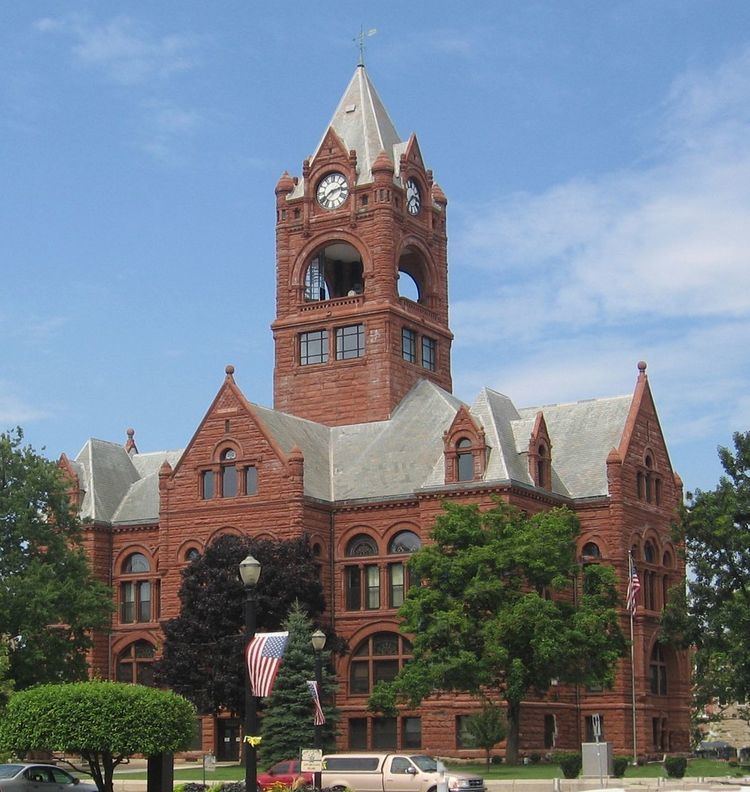Built c. 1860 (1860) NRHP Reference # 83000039 Added to NRHP 15 September 1983 | Architect Multiple Area 14 ha | |
 | ||
Location Roughly bounded by State, Jackson, Maple and Chicago Sts., LaPorte, Indiana Architectural style Queen Anne, Romanesque, Neo Classical | ||
Downtown LaPorte Historic District is a national historic district located at LaPorte, LaPorte County, Indiana. The district encompasses 70 contributing buildings in the central business district of LaPorte. It developed between about 1860 and 1930, and includes examples of Queen Anne, Romanesque Revival, and Neoclassical style architecture. Notable buildings include the Zahrt Blocks (1868, 1874), Ridgway Hotel (1863), Higday and Collins Blocks (1886-1888), LaPorte County Courthouse (1890-1894), Odd Fellows Building (1895), Lonn's Block (1889), People's Bank (1912), U.S. Post Office (1912), New York Central Depot (1909), Masonic Temple (1910), and Hotel Rumely (1912).
Contents
It was listed in the National Register of Historic Places in 1983.
History
The Downtown LaPorte Historic District reflects the development of LaPorte from a small town into a major manufacturing center La Porte was settled in 1830 and platted in 1833. With the arrival of the railroad in the 1850s, which first spurred the development of the business district. Among the earliest extant buildings in the district are the Zahrt Blocks built in 1874 and 1868, and the Ridgway Hotel built in 1863. These Italianate buildings are examples of the two-and three-story brick commercial buildings, which lined La Porte's downtown area. Common arch architectural details if the Italianate include: pressed metal cornices and window hoods, and storefronts with cast-iron columns. The downtown area occupies the location where two pre-European trails met. The number of lakes and wetlands to the north forced the town to firmer ground. The railroads arrived in the 1850s reinforcing development south of the lakes. Industrial growth was the main source of jobs until after World War I. The downtown reflects the legacy of commercial and civic history. Many of the structures have three stories: ground floor commercial with upper floors a combination of professional and residential use. The earliest buildings were constructed between the Civil War and the Panic of 1873. The Zahrt blocks (607-609 Michigan Avenue), constructed in 1868 and 1874, respectively, were purchased on speculation and resold to the developer. The tin brackets at the cornice and tin window hoods suggest a showiness that belies the buildings' otherwise severe and simple lines. The interiors are simple and lack any extravagance, indicating that the worth of the land was perceived to be rapidly escalating. In fact, other buildings like these were demolished and replaced with taller buildings as early as 1890. Another example of this type of development is the former Ridgway Hotel (401 Michigan), which was constructed in 1863. Its boxy mass is relieved with the use of window hoods, an elaborate cornice, and oriel windows. The structures along the 800 block of Lincolnway (810-20 Lincolnway) and those of the 700 block of Lincolnway follow this same design—consistent cornice lines, sparse Italianate detailing with window hoods, and boxy massing. This was the norm throughout the 1870s. Many of these early commercial buildings were replaced during the late nineteenth century. The focal point of the district, the La Porte County Courthouse, was constructed between 1890-1894. This Richardsonian Romanesque building was designed by Brentwood Tolan, who also designed other Indiana county courthouses. Many of the commercial buildings constructed during this period-exhibited ornate facades reflecting the owners' prospering businesses. The Lonn Block, the Ridgway Block, the Frederickson Building and the Guggenheim-Weil Building all prominently displayed the businessmen's names and the construction dates on their facades. Major buildings such as the city's post office, the train depot, and the Masonic Temple reflected a thriving economy. Commercial buildings such as the Hotel Rumely, the Peoples' Trust Savings Bank, the commercial building at 711 Indiana Avenue, and the Rumely Company Showroom were also built during this era.
Significant Buildings
Washington Street.
State Street.
Lincolnway.
Jefferson Avenue.
Maple Avenue.
Indiana Avenue.
Michigan Avenue.
Monroe Avenue.
